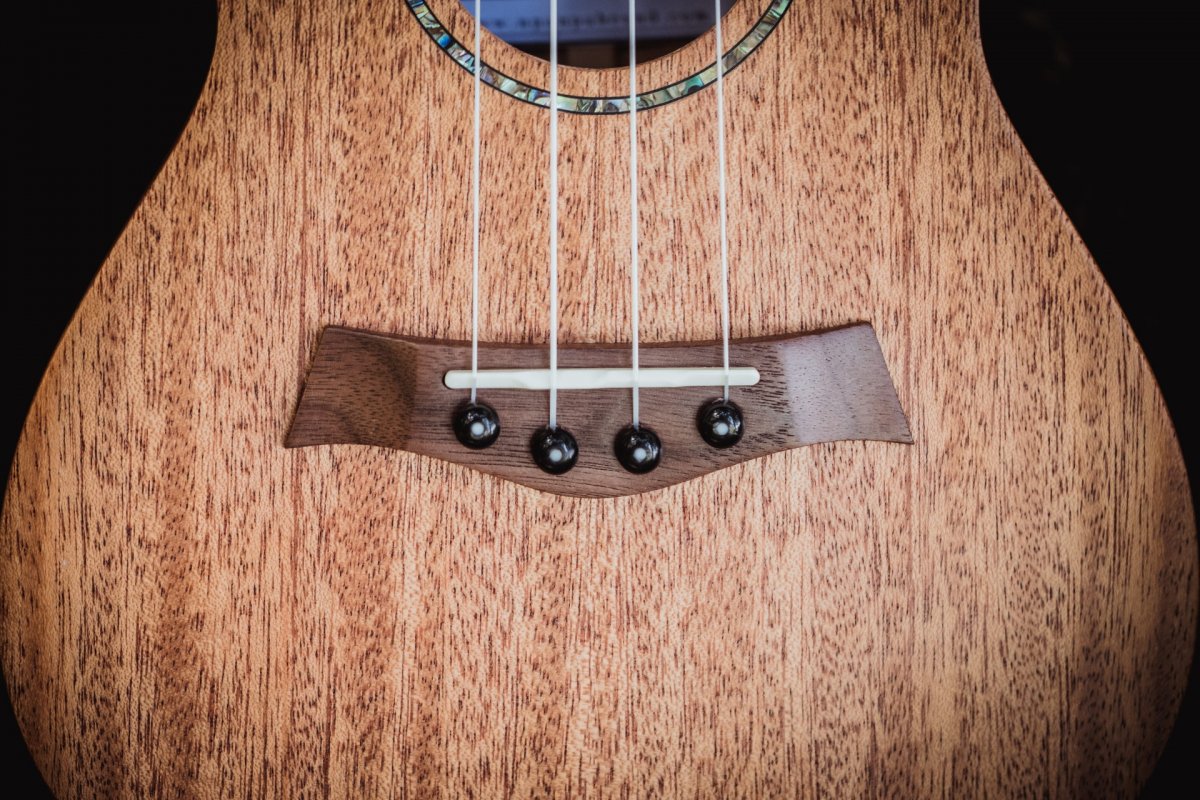

Introduction
The ukulele, originally from Hawaii, is a plucked string instrument that has conquered the world of music with its ease of learning and its unique sound. There are four main types of ukuleles: soprano, concert, tenor and baritone. In this article, we'll focus on the first two types, the soprano ukulele and the concert ukulele, and help you understand their differences, to help guide you in choosing the right instrument for you. Here is an overview of the points we will cover:
Size and dimensions
Differences in size and dimensions between soprano and concert ukuleles can have a significant impact on portability, sound, and playing comfort.
Here is a detailed comparison of the typical dimensions of these two types of ukuleles:
Soprano ukulele: Soprano ukuleles are the smaller of the two types, with an overall length of around 53 cm (21 inches) and a scale length (the distance between the nut and the bridge) of around 33 cm (13 inches). The body of a soprano ukulele is usually about 30 cm (12 inches) long, 16 cm (6,5 inches) wide and 6 cm (2,5 inches) deep. This compact and lightweight size makes it ideal for travel, children or people with small hands.
concert ukulele: Concert ukuleles are larger than soprano ukuleles, with an overall length of around 58 cm (23 inches) and a scale length of around 38 cm (15 inches). The body of a concert ukulele is typically about 33 cm (13 inches) long, 18 cm (7 inches) wide, and 7 cm (2,75 inches) deep. This larger size gives the concert ukulele a richer, more powerful sound, as well as better playability for people with large hands or who are used to playing guitar.
Pitch and tuning
The pitch of the soprano ukulele is usually 33 cm, while that of the concert ukulele is 38 cm. This difference in tuning fork influences the tension of the strings and the spacing between the frets. Both types of ukuleles are usually tuned in GCEA. However, the soprano ukulele can also be tuned to ADF#B, giving it a brighter tone.
sound and volume
The sound of a ukulele is influenced by several factors, such as the size of the sound box, the materials used, the build quality and the playing technique. As a general rule, soprano ukuleles have a higher pitched sound, more brighter and more "slamming" than concert ukuleles. Their smaller resonance box and shorter scale length help create that signature tone often associated with the "traditional" sound of the ukulele.
Concert ukuleles, on the other hand, offer a richer, fuller, and more balanced sound, thanks to their larger resonance box and longer scale length. Their sound is generally closer to that of a classical guitar, with deeper bass and better projection. The volume difference between the two types of ukuleles is also noticeable, with concert ukuleles generally being louder and having better projection than sopranos. This can be an advantage during solo or group performances, where greater sonic presence is desired.
It should also be noted that the quality of the strings plays a crucial role in the tone and volume of a ukulele. Poor quality strings can make even the best ukulele look dull and lifeless, while good quality strings can dramatically improve the sound of a low-end instrument. When buying a ukulele, it's often a good idea to invest in a quality set of strings to get the most out of your instrument.
Playability and comfort
Playability and comfort are key factors to consider when choosing a ukulele. Body size and shape, neck length and width, fret spacing, and string height (known as "action") are all things that can influence how easy and fun it is to play. instrument.
Soprano ukuleles, due to their smaller size and closer frets, are often better suited for people with small hands, children, or beginners who want to get started with a stringed instrument. Their compact size also makes them easier to transport and store, which can be an advantage for on-the-go musicians or those short on storage space.
Concert ukuleles, on the other hand, offer more finger room on the neck and frets, which generally makes them more comfortable for people with large hands, guitarists accustomed to a wider neck, or musicians advanced players who play more complex songs. Their larger body may also be more comfortable for some people to hold and play.
Ultimately, deciding between a soprano ukulele and a concert ukulele in terms of playability and comfort will largely come down to each musician's personal preference and body type. It is strongly recommended that you try out several instruments of different types and sizes to determine which one suits you best and gives you the best playing experience.
Materials and manufacturing
Soprano and concert ukuleles can be made from a wide variety of materials, which will impact the sound, look and price of the instrument. Here are some of the most common materials used in the manufacture of ukuleles:
- Solid wood : Solid wood ukuleles are generally considered the highest quality instruments because they offer superior resonance and projection. Koa, a Hawaiian wood, is the traditional material used to make ukuleles and provides a warm, rich sound. Other commonly used solid woods include rosewood, ebony, mahogany, and maple. Each of these woods will have a different influence on the sound of the instrument, as well as its appearance and weight.
- Laminated wood: Laminated wood ukuleles are made of thin layers of wood glued together. Although they are generally less expensive and less sensitive to variations in humidity than solid wood instruments, their sound can be less rich and less resonant. However, good quality laminated wood ukuleles can still offer excellent value for money and are ideal for beginners or budget conscious musicians.
- Synthetic materials: Plastic, polycarbonate or carbon fiber ukuleles offer a lightweight and durable alternative to wooden instruments. These synthetic materials are particularly suitable for travel, humid environments, or for children, as they are less likely to be damaged in the event of an impact. The sound of a synthetic material ukulele can be surprisingly good, although it is generally less warm and complex than that of a wooden instrument.
When it comes to manufacturing, it is crucial to pay attention to the quality of the instrument's finish, assembly and components. A neat and solid construction will guarantee better durability, better playing comfort and better sound quality. Items to check include the frets, tuners, nut, bridge, and quality of finish.
Prices and accessories
The price of soprano and concert ukuleles can vary widely depending on several factors, such as materials used, build quality, brand, and accessories included. Here are some things to consider when evaluating the price of a ukulele and related accessories:
- Entry level ukuleles: Entry-level soprano ukuleles are generally more affordable than concert ukuleles, due to their smaller size, simpler construction, and use of less expensive materials (like laminated wood or synthetic materials). The prices for these instruments can vary from 20 to 100 euros. Entry-level concert ukuleles are usually in the $50-$200 price range. These instruments are often aimed at beginners and offer good value for money for those who want to learn the ukulele without investing a large sum.
- Mid-range ukuleles: Mid-range ukuleles generally offer better build quality, higher quality materials, and additional features, like higher quality tuners or decorative inlays. Prices for mid-range soprano ukuleles are usually between $100 and $300, while mid-range concert ukuleles can cost between $200 and $500. These instruments are suitable for intermediate musicians or those who want to improve their beginner instrument.
- High end ukuleles: Premium ukuleles are made with premium materials, fine workmanship, and high-end features, like high-end tuners, elaborate inlays, and preamp systems for electric amplification. Prices for high-end soprano ukuleles can range from $300 to $1 or more, while high-end concert ukuleles can cost anywhere from $000 to $500 or more. These instruments are intended for advanced musicians, collectors or those looking for the best sound quality and aesthetics possible.
When it comes to accessories, it's important to consider the following when buying a ukulele:
- Covers and cases: A quality cover or case will protect your ukulele from bumps, scratches and variations in humidity. Padded cases are generally more affordable and lighter, while hard cases offer better protection but are bulkier and more expensive.
- Straps: A ukulele strap can make it easier to hold the instrument and improve playing comfort, especially for larger and heavier concert ukuleles
Conclusion
In conclusion, the main differences between a soprano ukulele and a concert ukulele are in their size, dimensions, pitch, sound, playability, price and the materials used in their manufacture. The choice between the two will depend on your personal preferences, playstyle, and budget.
The soprano ukulele is ideal for people looking for a compact, lightweight instrument with a bright, high-pitched sound often associated with the "traditional" ukulele sound. It is particularly suitable for beginners, children and those with small hands.
The concert ukulele, on the other hand, will be best suited to those who want an instrument with a richer, fuller sound, better projection, and more comfortable playability for larger hands or guitarists accustomed to a wider neck. Additionally, concert ukuleles are generally louder and have better sonic presence, which can be a plus during solo or group performances.
It is strongly recommended that you try out both types of ukuleles in the store or with friends before making a decision. Feel free to compare the different materials, quality levels, and accessories available for each type of ukulele. The key is to choose an instrument that makes you want to play and have fun with music, taking into account your specific needs and preferences!
